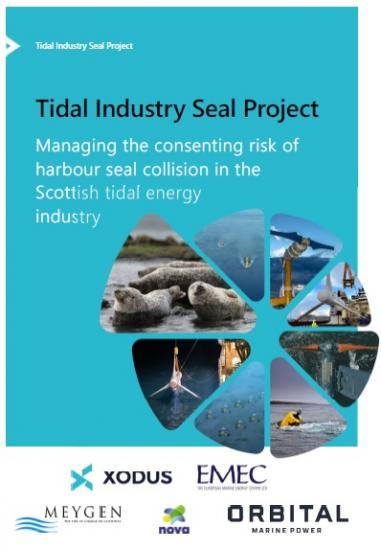New report charts path to unlocking Scotland's tidal energy potential
15th May 2025

Tidal stream energy sector calls for collaborative action to resolve consenting challenges and accelerate clean energy growth.
A new report published today, Managing the Consenting Risk of Harbour Seal Collision in the Scottish Tidal Energy Industry, sets out key recommendations to underpin robust consenting to enable the growth of tidal stream energy in Scotland while addressing environmental concerns - particularly the potential impact on harbour seals.
Funded by Crown Estate Scotland and Highlands and Islands Enterprise, the Tidal Industry Seal Project (TISP) report was developed with input from eight leading organisations in tidal energy and environmental assessment.
As a predictable and persistent source of renewable power, unlocking the full potential of tidal stream energy will strengthen energy security and bolster economic growth - imperative for Scotland and the UK to deliver their long-term net zero ambitions.
Home to some of the world's strongest tides, the Pentland Firth and Orkney Waters region is the epicentre of the UK's tidal energy sector. More technologies have been demonstrated, and more tidal power produced from its seas, than anywhere else in the world. This unique setting offers a testbed for developing marine energy at meaningful scale, shaped by local knowledge and environmental context.
However, commercial-scale project development is facing challenges in progressing responsibly given the complexity, uncertainty and long lead-times encountered with the current regulatory framework. Although extensive monitoring to date has found no evidence of seal-turbine collisions, a high level of precaution is still applied to the perceived risk - particularly in the context of ongoing harbour seal decline in the region. This highlights the need for science-led, proportionate approaches that uphold environmental protection while keeping pace with readiness for scaled deployment.
The tidal energy industry has formed a regional developer group and is committed to working together with regulators and research institutions to strengthen the evidence base on the seal collision risk with tidal turbines and increase the reliability and accuracy of impact assessments. This could involve the development of effective mitigations, better use of existing evidence, exploring opportunities to enhance the environment and trialling new monitoring technologies.
TISP sets out a series of recommendations calling for coordinated action across government, industry, regulators and key delivery bodies to strengthen policy, planning, evidence and monitoring frameworks.
Realising this coordinated approach will require proportionate, solutions-focused regulation, developed in partnership with key actors including NatureScot, that actively supports the responsible deployment of tidal stream energy in line with national goals. This approach should be underpinned by statistical methods and regional frameworks that better reflect population-scale ecological processes and long-term environmental change.
Dr Ewan Edwards, Environmental Specialist at Xodus explains:
"Harbour seal populations around Orkney and the north coast of Scotland have been in sharp decline for around 20 years. This is generally attributed to factors such as competition for food with other species, predation by killer whales or grey seals, and potentially biotoxins from algal blooms.
"Extensive monitoring of operational tidal projects in Scotland has found no evidence of seal-turbine collisions. On the contrary, data suggest that seals actively avoid operating turbines, especially during peak flows.
"The project team strongly believe that the weight of evidence suggests that collisions between harbour seals, or any other marine mammal, and tidal turbines are thankfully incredibly rare, and the risk of collision is a hypothetical one, rather than a realistic threat."
Donald Leaver, Environment and Consents Manager at EMEC, said, "We recognise that for the tidal energy to grow, a collaborative effort is required to better understand whether the potential for seals to collide with turbines is an issue. Pioneering projects led by MeyGen, Nova Innovation and Orbital Marine Power have investigated this over several years and, so far, haven't seen any evidence of seal-turbine collisions.
"With various new projects in the Pentland Firth and Orkney Waters due to be built out over the coming decade, supporting Scottish and UK government policy ambitions for energy security and climate resilience, it is vital this consenting uncertainty is resolved in a collaborative, science-led manner to enable sustainable development alongside the protection of our marine ecosystems."
Fraser Johnson, O&M Manager at MeyGen, commented, "We're proud to have played a leading role in improving how we assess and manage environmental risks for tidal energy. This report demonstrates the significant progress the sector has made; however, to unlock its full potential, we must continue to work collaboratively, share our learnings, and maintain this momentum.
"At MeyGen, we're committed to environmental stewardship but the consenting system must evolve to reflect both the latest evidence and ensure the scale of this vital technology is realised. Tidal stream energy has proven that it can be key in providing predictable, scalable renewable power, creating a thriving sector in the process. We must ensure we put in place a framework that enables responsible growth, builds trust, and delivers long-term value across communities, the environment, and those investing in a more resilient energy future. This work is part of our long-term commitment to the region, and we look forward to continuing the dialogue to support practical solutions."
The report was developed by a consortium including Xodus Group Ltd, Carronside Consultancy Ltd, SAE Renewables Ltd, European Marine Energy Centre Ltd, Eurona Consultancy Ltd, Burges Salmon LLP, Orbital Marine Power Ltd, and Nova Innovation Ltd.
Download he full report HERE
158 Pages
